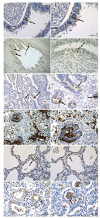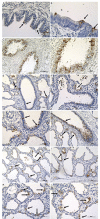Interindividual variability in the expression of surfactant protein A and B in the human lung during development
- PMID: 27734990
- PMCID: PMC5062633
- DOI: 10.4081/ejh.2016.2678
Interindividual variability in the expression of surfactant protein A and B in the human lung during development
Abstract
The surfactant complex, thanks to its multiple actions including decrease of surface- tension and antimicrobial activity, plays a fundamental role in newborn survival, lowering the risk of respiratory distress syndrome. The aim of this work was to determine if the synthesis of two surfactant proteins (SP), SPA and pro-SPB, shows some inter-individual variability during lung development in the intrauterine life. Immunoreactivity for SPA and pro-SPB was investigated in the lungs of 40 subjects, including 15 fetuses, ranging from 14 to 22 weeks of gestation, and 25 neonates, from 24 to 41 weeks. Lung samples were formalin fixed, paraffin-embedded and routinely processed. SPA and pro-SPB were detected utilizing commercial antibodies. A semi-quantitative grading system (1 to 4) was applied, based on the number of reactive cells and the intensity of immunostaining. Surfactant protein immunostaining was found in three compartments: bronchi, bronchioles and alveoli, starting from 14 weeks of gestation in the bronchial epithelium and from the 21st week in the alveolar spaces. Differences were found regarding SPA and pro-SPB expression in the vast majority of subjects: in some lungs, SPA was more expressed whereas in others pro-SPB showed an higher degree of immunoreactivity. The expression of both surfactant proteins was not strictly correlated with gestational age. Whereas the highest levels of reactivity were detected in at term neonates, on the other hand one case with grade 3 was detected at 22 weeks and one negative case for both proteins was observed at 31 weeks. Our data clearly show a marked inter-individual variability regarding the production of SPA and pro-SPB and suggest the existence of other epigenetic factors, acting during gestation, that might influence surfactant production and, consequently, the survival potential of neonates at birth.
Figures







References
-
- Goerke J. Pulmonary surfactant: functions and molecular composition. Biochim Biophys Acta 1998;1408:79-89. - PubMed
-
- Endo H, Oka T. An immunohistochemical study of bronchial cells producing surfactant protein A in the developing human fetal lung. Early Hum Dev 1991;25:149-56. - PubMed
-
- Weaver TE, Beck DC. Use of knockout mice to study surfactant protein structure and function. Biol Neonate 1999;76:15-8. - PubMed
-
- Lin S, Na CL, Akinbi HT, Apsley KS, Whitsett JA, Weaver TE. Surfactant protein B (SP-B)–/– mice are rescued by restoration of SP-B expression in alveolar type II cells but not Clara cells. J Biol Chem 1999;274:19168-74. - PubMed
-
- Khoor A, Stahlman MT, Gray ME, Whitsett J. Temporal-spatial distribution of SP-B and SP-C proteins and mRNAs in developing respiratory epithelium of human lung. J Histochem Cytochem 1994;42:1187-99. - PubMed
MeSH terms
Substances
LinkOut - more resources
Full Text Sources
Other Literature Sources

